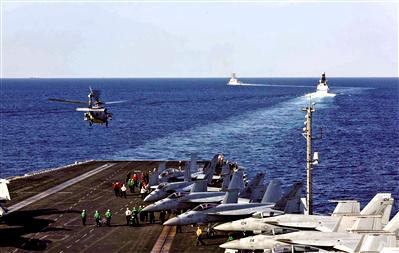
By Zhang Chi
As the COVID-19 pandemic continues to play havoc in the US, the US military is under a lot of pressure on pandemic prevention and control. In the meantime, however, it is flexing muscles in multiple regions around the world, which has drawn close attention as that not only brings potential trouble for its development but also causes adverse effects on regional security.
The US is flexing muscles everywhere.
The US President Donald Trump summoned military generals to the White House on May 9, where he proclaimed on a high profile that the government would spend USD1.5 trillion rebuilding the US military. The military also flexed muscles around the world recently to demonstrate that the pandemic hasn't weakened its strength in the least.
On the one hand, the US Navy is flaunting the combat force of aircraft carriers. It declared on May 10 that over half of America's aircraft carriers are on the voyage now, which was corroborated by US media who claimed that the pandemic hasn't undermined the US Navy's combat force despite various setbacks.
According to a latest report, over 1/3 of the 299 American naval vessels that are performing their maritime tasks haven't reported any COVID-19 infections.
On the other hand, the US Air Force performed the "elephant walk." An American military website reported that the USAF performed an elephant walk at the Joint Base Elmendorf-Richardson, Alaska on May 5, followed by integrated training in the Joint Pacific Alaska Range Complex, which showcased the USAF's capability of immediate response, resilience and global reach, according to Colonel Robert Davis, Commander of USAF 3rd Wing.
The US is enhancing combat readiness.
The US Defense Secretary Esper recently said that learning how to meet the training and combat readiness demands next year or until the emergence of the COVID-19 vaccine will be a new normal for the Pentagon. To this end, the US military has recently strengthened cooperation with its allies and continued to promote combat-readiness training.
According to reports by the Air Force Times, a weekly newspaper published in the US, the USAF recently assigned three types of strategic bombers to Europe, which was a way of telling the world that "the US Strategic Command is capable of maintaining the operational and global coverage capabilities of the strategic bomber force."
On the Asia Pacific, CNN reported that the US Pacific Air Force on May 1 announced the arrival of four B-1 bombers that boast the most massive weapon payload of all USAF aircraft at Guam's Andersen Air Force Base. It is learnt that they were to carry out training and perform strategic deterrence missions in the Asia Pacific.
According to a US naval officer, the newly arrived B-1 bombers can carry more weapons than the former B-52, including long-range anti-ship ballistic missiles. A former official at the Joint Intelligence Center of US Pacific Command pointed out that the unpredictability of the deployment would make it more difficult for the adversary to respond.
The US’ muscle-flexing reveals its anxieties.
Generally speaking, the US military is displaying its strength and combat-readiness training on such a high profile mainly to ease the external concern that the COVID-19 outbreak may have taken a toll on its combat capabilities, and to deflect the criticism of its inadequate outbreak response. Going forward, the US military's muscle-flexing moves will cause negative impacts on itself and regional security.
The epidemic prevention and control in America is facing more risks. The US Pentagon on May 12 released the news that 5,036 American service members and civil staffs have been infected with coronavirus, which amounts to 8,046 combined with infected family members.
Of the six aircraft carriers that claimed to set out for missions, the USS Nimitz and USS Ronald Reagan have both reported sailor infections, and the USS Harry S. Truman hasn't had a port visit for fear of infection. While the outbreak is far from being brought under effective control, the US military's constant display of strength and combat readiness training will put the efforts of pandemic control at higher risk.
The regional situation may become more unstable. The US military's constant muscle-flexing in Europe has incurred a strong response from Russia. The Russian and American air combat and reconnaissance forces have had multiple encounters recently in air space over the Baltic Sea, bringing uncertainties to regional security.
The Japan Times also reported that the US military also plans to equip its marines deployed in the Asia Pacific with the Tomahawk cruise missiles to counter the "predominant land-based cruise missiles and ballistic missiles" deployed by potential rivals in the region. This is bound to incur relevant countries' discontent and spark a new round of regional turbulence.













